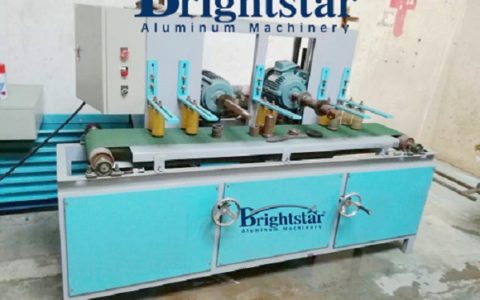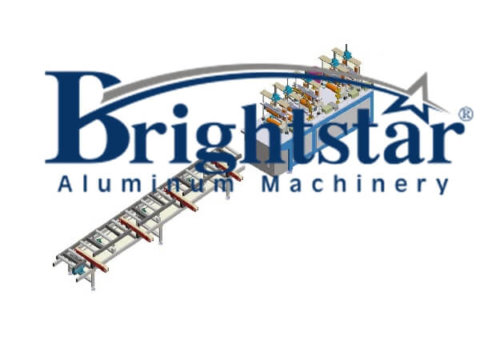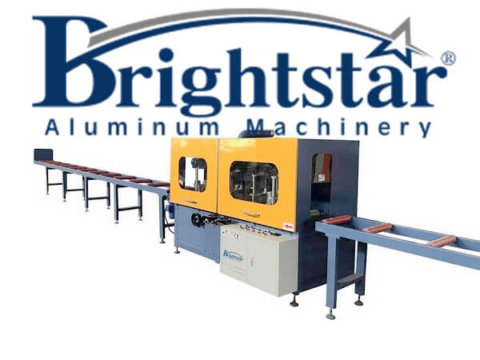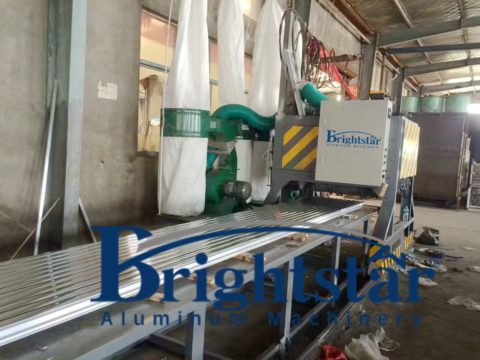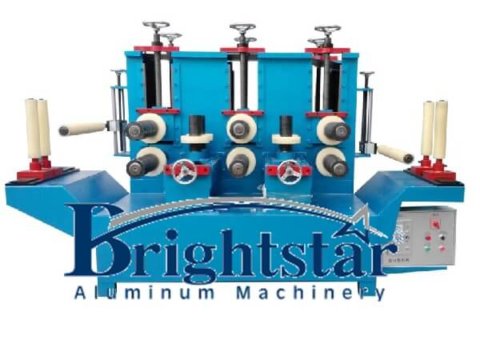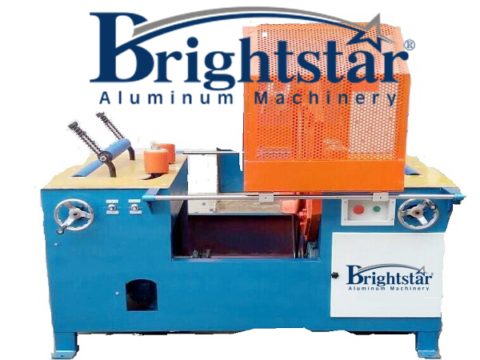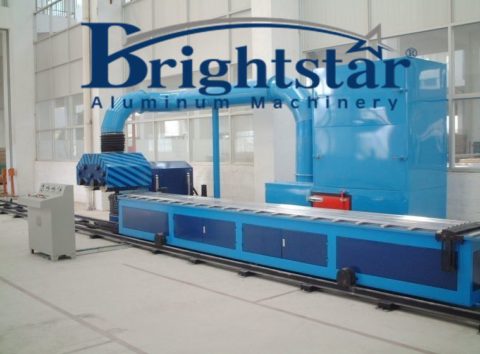
Double shaft aluminum profile brushing machine
Double shaft aluminum profile brushing machine
Double shaft aluminum profile brushing machine
The aluminum profile brushing machine makes the decoration line on the aluminum profile surface through the brushing wheel, can get straight grain, curly grain, ripple grain and irregular line or hairline finish with different model and mesh brushing wheels.
An aluminum profile brushing machine is a specialized piece of equipment designed for the surface treatment of aluminum profiles.
The brushing process is essential for enhancing the aesthetic appearance of aluminum profiles, removing burrs, and creating a uniform finish and hairline finish.
Brushing: Each brush head spins rapidly, effectively removing surface imperfections, creating a uniform textured finish, and enhancing the overall aesthetic appeal of the profiles.
Profile Handling: A conveyor system smoothly feeds the profiles through the machine, ensuring efficient and continuous brushing on both sides.
Here’s an introduction to such a machine along with its features:
Introduction:
Purpose:
Aluminum profile brushing machines are used to brush the surfaces of aluminum profiles to get the hairline finish.
They are commonly employed in industries such as construction, architecture, automotive, and furniture manufacturing.
Process:
The machine utilizes brushes or abrasive belts to scrub the surface of aluminum profiles.
The brushing process helps to remove oxide layers, burrs, and other impurities, resulting in a smoother and more hairline finish.
Types:
There are different types of aluminum profile brushing machines, including manual, semi-automatic, and fully automatic models.
An aluminum profile brushing machine plays a crucial role in enhancing the surface quality of aluminum profiles, and its features are designed to provide efficiency, flexibility, and quality control in the brushing process. The specific features may vary based on the manufacturer and model of the machine.
This machine is equipped with two shafts with the following features
1. Because the main shaft speed is variable frequency, you can change the brushing wheel, and nylon wheel separately to achieve the brushing and wire drawing functions in this machine.
2. In the use of two main shafts, you can choose a variety of combinations to improve the efficiency of wire drawing.
Aluminum profile brushing can eliminate scratches, marks, etc. on aluminum profiles.
The degree of elimination is related to the depth of brushing.
Generally speaking, the greater the depth of brushing, the stronger the ability to eliminate physical defects on the surface of aluminum profiles.
However, for the high request for the brushing process, it is necessary to use pre-treatment such as grinding or polishing to eliminate the surface defects of the workpiece before brushing, especially for lighter brushing hairlines.
In addition to eliminating the surface defects of aluminum alloy workpieces mentioned above, brushing can improve the texture of metal materials and provide it with a strong decorative effect to increase the aesthetics of the product.
This is currently the most commonly used method for the decoration on aluminum profiles.
In recent years, aluminum profile brushing has been widely used for shell decoration of various electronic products, such as laptop panels, keyboards, mobile phone panels and other related components of digital products.
Aluminum profile surface brushing is carried out with an aluminum profile brushing machine.
For small flat workpieces, a flat-press abrasive belt brushing machine can be used.
This brushing method depends on the surface requirements of the product.
You can choose a coarse-grained abrasive belt to process a heavy brushing line, or textured surface.
For the light pattern with obvious hand feeling, you can also use the fine-grained abrasive belt to process a more delicate light brushing line pattern.
Key Features:
Dual brush heads: The heart of the machine lies in its two independently controlled brush heads, allowing for different brush types, speeds, and pressures on each side, catering to diverse finishing needs.
Adjustable brush settings: Brush speed, pressure, and angle can be precisely adjusted for each head, enabling customized finishes for different profile thicknesses and desired textures.
Versatile brush options: A variety of brush materials, like nylon, wire, or abrasive discs, can be used to achieve specific brushing effects, ranging from light polishing to deep texturing.
Efficient dust extraction (optional): Some models come equipped with a dust extraction system to control dust generated during the brushing process, promoting a cleaner work environment.
User-friendly control panel: The machine operates through a user-friendly interface for easy adjustments, monitoring, and error detection.
Advantages:
Double the efficiency: Brushing both sides simultaneously significantly reduces production time compared to single-shaft machines, boosting overall output and productivity.
Enhanced versatility: Independent control of each brush head opens up a wider range of finishing possibilities, catering to diverse profile designs and finishing requirements.
Improved quality control: Precise adjustments for each side ensure consistent and high-quality finishes across all profiles.
Reduced labor costs: Automated brushing minimizes the need for manual handling, leading to lower labor costs and improved operational efficiency.
Dust-free environment (optional): Integrated dust extraction creates a cleaner and safer work environment for operators.
Applications:
Architectural and construction: Brushing window frames, door frames, and building cladding profiles for a sleek and contemporary look.
Furniture and interior design: Adding a touch of elegance to furniture components, shelves, and decorative elements.
Automotive and transportation: Enhancing the visual appeal of vehicle trim pieces and other exposed components.
Electronics and appliance manufacturing: Applying brushed finishes to various electronic components and appliance casings for a premium look.
Working principles of double shaft aluminum brushing machine
By the rotation of nylon wheels in the main shaft that were driven by the motor, makes the machining work on the surface of aluminum profiles to obtain the decorative lines on the surface.
You can adjust the shaft speed, working table feeding speed or change different types of nylon wheels to get different decorative lines.
Technical parameter
1. Total length 15 meters, 1.5m width
2.Main machine overall size:1360mm Height X2400mm LengthX1500mm Width
3. Conveying frame:450mm Width X800mm HeightX 4500 mm Length 2 sets
4. Brushing working dimension: 280mm Width x 220mm Height More than 500mm less than 12 meters
5. Brushing motor: 4KW-4 (2 sets)
6. Driving motor: 0.75KW
The brushing effect can be customized according to your request.
Your request is our motivation!
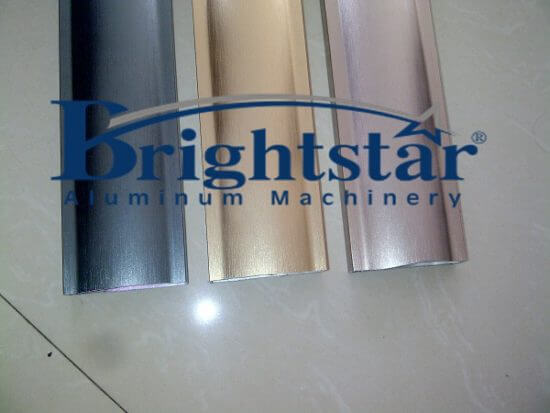
Aluminum profile brushing effect
Overall, the Double Shaft Aluminum Profile Brushing Machine is a powerful tool for businesses seeking to maximize efficiency, versatility, and quality control in their profile finishing process.
Its dual-brush capabilities, independent control options, and diverse finishing possibilities make it an ideal choice for industries where premium aesthetics and high-quality finishes are paramount.
Contact us now to obtain a reliable no-obligation quote on your aluminum profile brushing machine.
How do you get the hairline finish on aluminum profile?
Achieving a hairline finish on aluminum profiles involves a meticulous process of surface treatment and polishing.
Here are the general steps to attain a hairline finish:
Surface Preparation:
Cleaning:
Start by thoroughly cleaning the aluminum profiles to remove any dirt, grease, or contaminants.
Deburring:
Remove any sharp edges or burrs from the profiles using deburring tools or equipment.
Brushing:
Use a Brushing Machine:
Employ an aluminum profile brushing machine with abrasive brushes to refine the surface further. This helps in achieving a consistent and directional pattern, contributing to the hairline finish.
Select the Right Brush:
Choose the appropriate type and grit of brush for the specific finish you want. Finer brushes or abrasive belts are typically used for achieving a hairline finish.
Final Finishing:
Inspect and Touch Up:
Inspect the profiles for any remaining imperfections or uneven areas. Touch up these spots with finer abrasives or repeat the brushing and polishing process.
Clean the Surface:
After achieving the desired finish, clean the aluminum surface thoroughly to remove any polishing residues.
Tips:
Consistent Direction: Ensure that all brushing and polishing strokes are in the same direction to maintain a uniform hairline pattern.
Use Professional Equipment: Investing in professional brushing and polishing equipment designed for aluminum surfaces will yield better and more consistent results.
Experiment with Grits: Experiment with different grit sizes of abrasives during the sanding and brushing stages to find the combination that achieves the desired hairline finish.
Protective Measures: Use appropriate safety gear, including gloves and eye protection, when working with abrasives and polishing compounds.
Remember that achieving a high-quality hairline finish requires patience, attention to detail, and the use of proper equipment and materials.
Additionally, the specific steps and techniques may vary based on the type of aluminum alloy and the desired final appearance.
What is the difference between aluminum profile brushing machine and aluminum profile surface defects brushing and cleaning machine?
The difference between an aluminum profile brushing machine and an aluminum profile surface defects brushing and cleaning machine lies in their specific functions and the extent of surface treatment they provide:
- Aluminum Profile Brushing Machine:
- Function: A standard aluminum profile brushing machine is primarily designed to brush the surface of aluminum profiles to achieve a uniform texture or finish. It typically utilizes rotating brushes or abrasive belts to mechanically brush the surface of the profiles.
- Process: The brushing machine works by mechanically abrading the surface of the aluminum profiles, creating a consistent texture or grain pattern. This process may involve the use of different brush types, abrasives, or brush configurations to achieve the desired finish.
- Result: The main objective of a brushing machine is to provide a uniform and aesthetically pleasing surface texture on the aluminum profiles. This may involve brushing to create a matte finish, satin finish, or other textured surfaces, depending on the requirements of the application.
- Application: Brushing machines are commonly used in industries where surface aesthetics or texture are important, such as architectural aluminum fabrication, furniture manufacturing, automotive trim production, and industrial applications where a non-reflective finish is desired.
- Aluminum Profile Surface Defects Brushing and Cleaning Machine:
- Function: An aluminum profile surface defects brushing and cleaning machine, on the other hand, is specifically designed to address surface defects, contaminants, and debris on aluminum profiles. It aims to clean and prepare the surface of the profiles for further processing or finishing.
- Process: This machine typically incorporates brushing or scrubbing mechanisms along with cleaning agents or water jets to remove oxidation, stains, dirt, corrosion, or other imperfections from the surface of the aluminum profiles.
- Result: The primary outcome of a surface defects brushing and cleaning machine is to ensure that the aluminum profiles are free from defects and contaminants, providing a clean and uniform surface ready for subsequent processing steps such as anodizing, painting, or powder coating.
- Application: Surface defects brushing and cleaning machines are commonly used in aluminum extrusion plants, manufacturing facilities, or finishing shops to prepare profiles for further processing or finishing. They are particularly useful for removing surface imperfections that may affect the quality or appearance of the final product.
In summary, while both types of machines involve brushing the surface of aluminum profiles, the standard brushing machine focuses on providing a desired texture or hairline finish, while the surface defects brushing and cleaning machine is specifically designed to clean and prepare the surface of the profiles by removing defects and contaminants.
